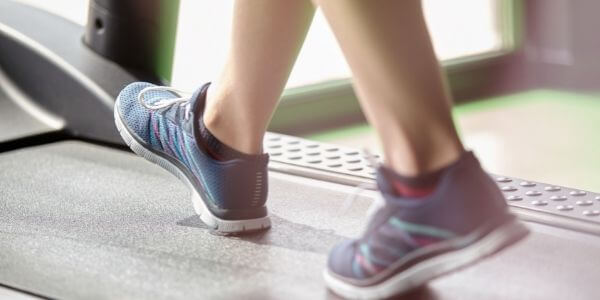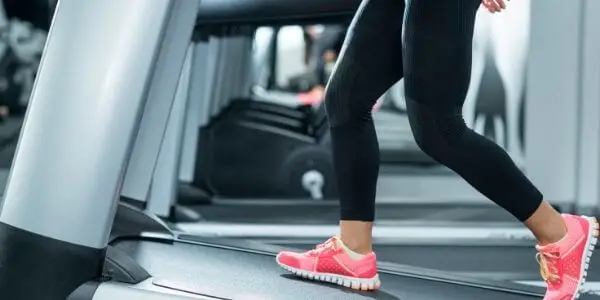Incline treadmills help you challenge yourself more, whether you’re into running or walking. As such, you can achieve your fitness and health goals faster.
However, incline treadmills aren’t devoid of risks.
We’ll discuss all that below.
Table of Contents
Benefits Of Incline Walking
Incline walking has many advantages to consider, many of which are backed by science. Let’s review them below.
1. Improved Heart Rate
When you’re walking on an incline, your heart rate increases even if your speed stays the same.
Some studies point out that just a 15% increase in incline brings your heart rate from 148 to 188 beats per minute. Besides, 15% is what most treadmills usually offer, though you can adjust this gradient however you see fit.
The same study shows that even a 2% incline increases your heart rate significantly.
Why is this important?
Before answering this question, here’s a:
Safety warning: Ask your doctor or physical therapist how hard you can work your heart. If you have preexisting cardiovascular conditions, respiratory problems, endocrine issues, a history of fainting, or whatever else you can think of, speak with your physician first.
That said, increasing your heart rate means exercising your healthy heart because that’s a muscle too. So a stronger heart leads to better blood circulation, which means more oxygen to your organs and brains so you can lead a healthier life.
Besides, a stronger heart decreases the risk of certain cardiovascular conditions or even alleviates your current symptoms. But we can’t stress this enough, talk with your doctor if you have heart problems.
2. Conditioning

Much like life, urban and rural terrains come with their ups and downs. You have stairs, hills, ramps, and so forth.
It’s wise to train for these.
If you’re getting a treadmill because you’re mobility-challenged, one with an incline will improve your functional strength too. In just a few weeks, you’ll be able to stand up faster, climb some stairs, or sit up your chair with less support.
If you’re getting a treadmill because you want endurance training, choose one with an incline too. Working out three times per week will improve your conditioning before a strenuous hike or a marathon.
3. You’ll Get A Stronger – And Healthier – Butt
Everyone knows that walking uphill makes your butt and back of your thighs hurt like hell. Firing up your glutes and hamstrings leads to that round look everyone’s craving nowadays.
But apart from shaping your bum, working your posterior chain muscles has a slew of health benefits we bet you didn’t know.
For example, strong glutes offer better back support that leads to improved posture and diminished chronic pain. In turn, that leads to an overall decreased risk of injuries.
Besides, more muscular legs and butt increase your exercise performance, allowing you to work out more efficiently and become stronger.
That’s pure science.
4. Stronger Ankles

Walking on an incline brings your calves on fire too. Just imagine the motion of climbing: pushing & stretching your shins and calves alternatingly.
These movements are shown to strengthen weak ankles, which themselves lead to a host of problems:
- Chronic imbalance
- Increased risk of falling and injury
- Sore feet
- Back pain
- And so forth
The good news is that even a 3ᵒ incline is enough to strengthen your ankles so that you can avoid these problems.
5. Low-Impact Calorie Burn
Walking or running on an incline increases your calorie burn because the slope increases the resistance on your muscles. As such, your muscles will work harder, so they’ll need more fuel. That fuel is initially carbs and blood glucose but, if you’re pushing yourself hard enough and for long enough, your muscles will start burning fat as fuel.
And so you can say goodbye to your fat stores.
Besides, walking at an incline increases your metabolism from 3.3 W/kg at 0% incline to 52 W/kg at 5% incline and 113 W/ kg at 10% incline. That’s increasing your metabolic rate 16 times at 5% incline and 34 times at 10% incline.
Imagine what that can do to your weight loss in the long term.
And even better, you’re achieving this high metabolic rate without the need to run.
That’s a massive advantage if:
- You have chronic pain
- You have weak joints that don’t allow you to run, but you want to strengthen them
- You have preexisting conditions that prevent you from doing high-impact activities
- You simply don’t like running
6. Versatility

An incline adds more versatility to your workout, which is essential from two perspectives. One, it prevents boredom, so you don’t quit exercising.
Secondly, it prevents goal plateaus. If you didn’t know this term, plateauing means stagnation in weight loss or shaping your body. That usually happens when your body gets very used to a specific type of exercise, so it doesn’t expend any more energy on it.
So variation is essential to keep your body and brain guessing.
Just adding an incline once in a while offers enough change, but why not spruce things up even more?
Try lunges on an incline, high knees, or even skips. Your body will be forced to adapt so that your metabolism will stay accelerated.
Plus, you’ll never get bored.
7. Prevents Exhaustion
Although you’re burning a lot of calories, walking on an incline feels easier. That way, you’re actually breathing better, and you’re preventing exhaustion.
That’s important because many people who want to shape their body quickly will overdo it with cardio.
However, doing this just tears your muscles and increases your risk of injury. Remember that you don’t want to drain your body completely; you want your workouts to energize you and keep you happy.
Otherwise, you’re just going to resort to binge eating, or you’ll become a couch potato for the rest of the day.
Conversely, walking at an incline feels good-tough so that you won’t lose your breath or damage your muscles.
Incline Treadmill Disadvantages

Now that we’ve seen the benefits of walking incline on a treadmill let’s discuss the drawbacks.
1. Muscle Soreness
We already explained how walking/ running on an incline activates your calves more than using a flat-surfaced treadmill. Well, this increased activation can lead to all sorts of cramps in this area if you’re not careful.
If you want to avoid that, start with just a few minutes on a shallow incline until your body gets used to the movements. Also, remember to drink lots of water because dehydration leads to muscle cramps too.
2. Shin Splints
Incline walking & running puts more pressure on your shins. That’s why you should always listen to your body and never push too hard.
There’s a subtle line between good pain and bad pain when it comes to exercise, and it takes time to learn the difference.
In the meantime, the best advice is to start slowly. Don’t fix your treadmill at a 20ᵒ incline to start running on this slope. Instead, try just regular walking at a 5ᵒ incline and see how your body is reacting.
If you go by this smartly, you’ll strengthen your bones in the long term instead of hurting them.
3. Lower Back Problems
If you have chronic health conditions affecting your lower back, ask your doctor or physical therapist if you should use an incline treadmill. That’s because higher inclines put more stress on your lower back and hips, which can prove damaging for chronic pain.
But remember, the studies we cited above show that even a 2-3ᵒ gradient has fantastic effects on your heart health and metabolic rate.
Thus, you too can benefit from an incline treadmill if you follow your doctor’s advice.
In Conclusion
Working out on an incline treadmill improves heart health, hastens calorie burn, and activates your lower body muscles. As such, this low-impact workout will make you stronger and healthier.
Conversely, incline walking & running can be dangerous if you’re overdoing it or not following your doctor’s orders. Make sure to double-check with them, especially if you have chronic conditions.
Also, remember that not all incline treadmills are good enough for your goals; some only provide mild inclines while others have few increments. So, do your homework before purchasing – we’ve plenty of reviews on this website to get you started.
- 7 Exercises for Pregnant Women in the First Trimester: Safe and Effective - January 30, 2025
- Our equipment recommendations - October 30, 2024
- Here’s What Doing Cardio Every Day Does To Your Body - August 21, 2024

